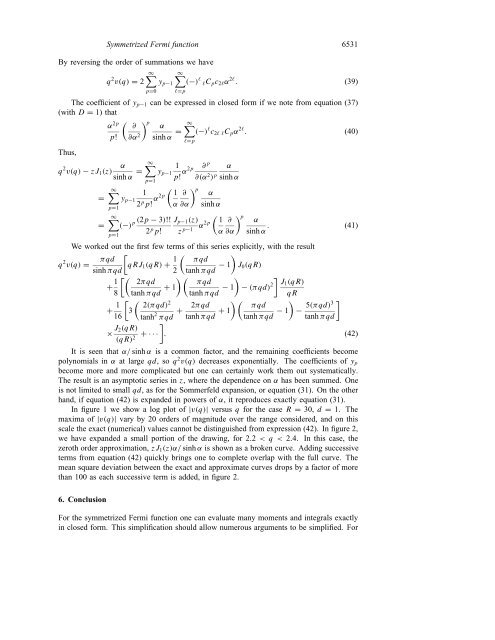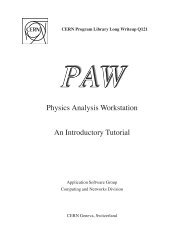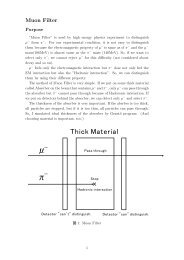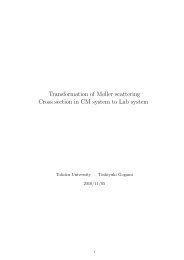The symmetrized Fermi function and its transforms
The symmetrized Fermi function and its transforms
The symmetrized Fermi function and its transforms
Create successful ePaper yourself
Turn your PDF publications into a flip-book with our unique Google optimized e-Paper software.
Symmetrized <strong>Fermi</strong> <strong>function</strong> 6531<br />
By reversing the order of summations we have<br />
∞∑ ∞∑<br />
q 2 v(q) = 2<br />
(−) l lC p c 2l α 2l . (39)<br />
p=1<br />
y p−1<br />
p=0 l=p<br />
<strong>The</strong> coefficient of y p−1 can be expressed in closed form if we note from equation (37)<br />
(with D = 1) that<br />
α 2p ( ) ∂ p<br />
α<br />
∞∑<br />
p! ∂α 2 sinh α = (−) l c 2ll C p α 2l . (40)<br />
l=p<br />
Thus,<br />
q 2 α<br />
∞∑<br />
v(q) − zJ 1 (z)<br />
sinh α = 1 ∂ p α<br />
y p−1<br />
p! α2p ∂(α<br />
p=1<br />
2 ) p sinh α<br />
∞∑<br />
( )<br />
1 1 ∂ p<br />
α<br />
= y p−1<br />
2 p p! α2p α ∂α sinh α<br />
)<br />
∂ p<br />
α<br />
∂α sinh α . (41)<br />
∞∑<br />
(<br />
p<br />
(2p − 3)!! J p−1 (z) 1<br />
= (−) α 2p<br />
2<br />
p=1<br />
p p! z p−1 α<br />
We worked out the first few terms of this series explicitly, with the result<br />
q 2 v(q) =<br />
πqd [<br />
qRJ 1 (qR) + 1 ( )<br />
πqd<br />
sinh πqd<br />
2 tanh πqd −1 J 0 (qR)<br />
+ 1 [( )(<br />
) ] 2πqd<br />
πqd<br />
8 tanh πqd +1 tanh πqd −1 −(πqd) 2 J1 (qR)<br />
qR<br />
+ 1 [ ( 2(πqd)<br />
2<br />
3<br />
16 tanh 2 πqd + 2πqd )(<br />
)<br />
πqd<br />
tanh πqd +1 tanh πqd −1<br />
− 5(πqd)3<br />
tanh πqd<br />
× J 2(qR)<br />
(qR) 2 +···]<br />
. (42)<br />
It is seen that α/ sinh α is a common factor, <strong>and</strong> the remaining coefficients become<br />
polynomials in α at large qd, soq 2 v(q) decreases exponentially. <strong>The</strong> coefficients of y p<br />
become more <strong>and</strong> more complicated but one can certainly work them out systematically.<br />
<strong>The</strong> result is an asymptotic series in z, where the dependence on α has been summed. One<br />
is not limited to small qd, as for the Sommerfeld expansion, or equation (31). On the other<br />
h<strong>and</strong>, if equation (42) is exp<strong>and</strong>ed in powers of α, it reproduces exactly equation (31).<br />
In figure 1 we show a log plot of |v(q)| versus q for the case R = 30, d = 1. <strong>The</strong><br />
maxima of |v(q)| vary by 20 orders of magnitude over the range considered, <strong>and</strong> on this<br />
scale the exact (numerical) values cannot be distinguished from expression (42). In figure 2,<br />
we have exp<strong>and</strong>ed a small portion of the drawing, for 2.2









